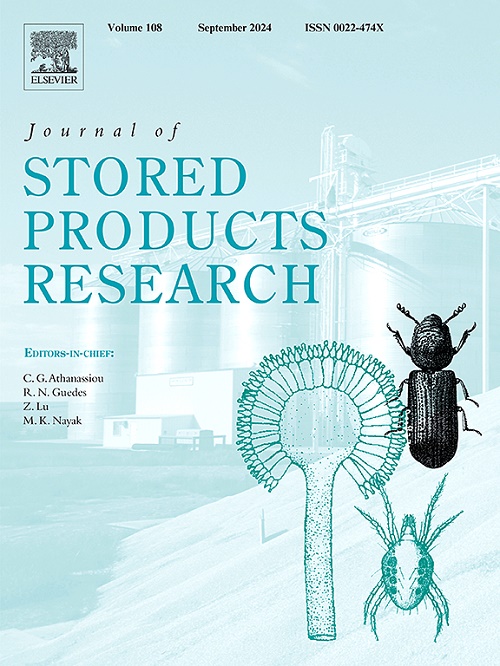Physical properties and quality of corn grains stored at different initial moisture contents under hermetic and non-hermetic conditions
IF 2.7
2区 农林科学
Q1 ENTOMOLOGY
引用次数: 0
Abstract
The aim of this study was to evaluate the dynamics of the CO2 concentration and its relationship with the quality of corn grains stored at different initial moisture contents under different conditions. The experiment was conducted in a completely randomized design, with a 2 × 3 × 5 factorial scheme and 3 replications. A sensor was inserted into the grain mass to measure CO2, temperature and relative humidity levels at 1-h intervals for up to 120 days, and quality assessments were performed every thirty days via physical properties and grain classification (official Brazilian standard IN 60/2011). The data were subjected to analysis of variance, followed by a t-test for storage conditions and linear regression for initial moisture content and storage time. The variation in temperature, relative humidity and CO2 resulted in greater metabolic activity for the non-hermetic condition and higher initial moisture content; grains stored with an initial moisture content of 14% wb presented lower levels of deterioration, with higher bulk density values and lower grain mass porosity; color variation increased as a function of time and initial moisture content; grains stored under hermetic conditions changed to type 2 at 120 days for an 18% wb initial moisture content, whereas in the non-hermetic storage, the changes began after 30 days for 16 and 18% wb, whereas for 14% wb, the change occurred at 120 days. The integrated use of temperature sensors, combined with relative humidity and CO2 monitoring, makes CO2 sensors valuable tools for preventing quality loss during storage.
在密闭和非密闭条件下以不同初始含水量储存的玉米粒的物理特性和质量
本研究旨在评估二氧化碳浓度的动态变化及其与在不同条件下以不同初始含水量储存的玉米粒质量的关系。实验采用完全随机设计,2 × 3 × 5 因子方案,3 次重复。将传感器插入谷物中,每隔 1 小时测量一次二氧化碳、温度和相对湿度水平,最长持续 120 天,每隔 30 天通过物理特性和谷物分类(巴西官方标准 IN 60/2011)进行一次质量评估。对数据进行方差分析,然后对储存条件进行 t 检验,对初始含水量和储存时间进行线性回归。温度、相对湿度和二氧化碳的变化导致非恒温条件下的新陈代谢活动更活跃,初始含水量更高;初始含水量为 14% wb 的谷物变质程度更低,体积密度值更高,谷物孔隙率更低;颜色变化随时间和初始含水量的变化而增加;在密闭条件下储存的谷物,初始含水量为 18% wb 时,120 天后变为 2 型;而在非密闭条件下储存的谷物,初始含水量为 16% 和 18% wb 时,30 天后开始发生变化,而初始含水量为 14% wb 时,120 天后发生变化。温度传感器与相对湿度和二氧化碳监测的综合使用,使二氧化碳传感器成为防止贮藏期间质量损失的重要工具。
本文章由计算机程序翻译,如有差异,请以英文原文为准。
求助全文
约1分钟内获得全文
求助全文
来源期刊
CiteScore
5.70
自引率
18.50%
发文量
112
审稿时长
45 days
期刊介绍:
The Journal of Stored Products Research provides an international medium for the publication of both reviews and original results from laboratory and field studies on the preservation and safety of stored products, notably food stocks, covering storage-related problems from the producer through the supply chain to the consumer. Stored products are characterised by having relatively low moisture content and include raw and semi-processed foods, animal feedstuffs, and a range of other durable items, including materials such as clothing or museum artefacts.

 求助内容:
求助内容: 应助结果提醒方式:
应助结果提醒方式:


